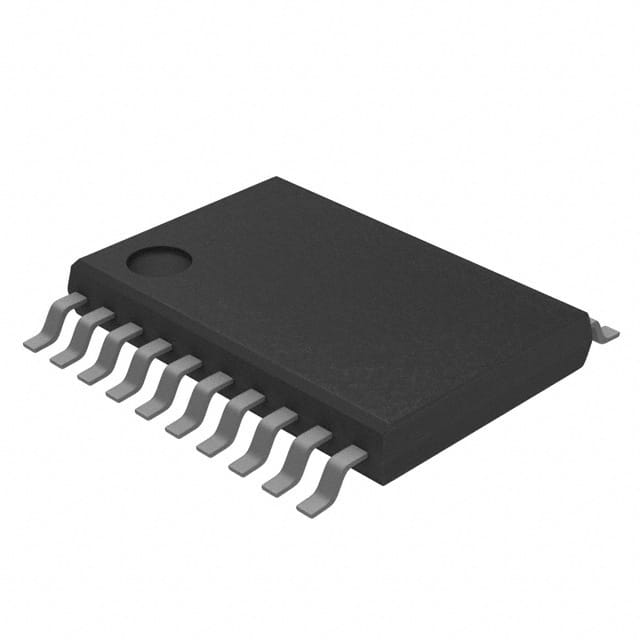Xem thông số kỹ thuật để biết chi tiết sản phẩm.

SN74ABTR2245PWG4
Product Overview
- Category: Integrated Circuit
- Use: Signal Transceiver
- Characteristics: Bi-directional, Octal Bus Transceiver
- Package: TSSOP (Thin Shrink Small Outline Package)
- Essence: High-performance, low-power transceiver
- Packaging/Quantity: Tape and Reel, 2500 pieces per reel
Specifications
- Supply Voltage Range: 2 V to 6 V
- Input/Output Voltage Range: 0 V to VCC
- Operating Temperature Range: -40°C to +85°C
- Output Drive Capability: ±12 mA at 3.3 V
- Propagation Delay: 7 ns (Max) at 3.3 V
- ESD Protection: Human Body Model > 2000 V
Detailed Pin Configuration
The SN74ABTR2245PWG4 has a total of 24 pins, which are arranged as follows:
- OE (Output Enable) 1
- A1 (Input/Output) 1
- B1 (Input/Output) 1
- GND (Ground)
- B2 (Input/Output) 2
- A2 (Input/Output) 2
- OE (Output Enable) 2
- VCC (Supply Voltage)
- B3 (Input/Output) 3
- A3 (Input/Output) 3
- B4 (Input/Output) 4
- A4 (Input/Output) 4
- OE (Output Enable) 3
- GND (Ground)
- A5 (Input/Output) 5
- B5 (Input/Output) 5
- A6 (Input/Output) 6
- B6 (Input/Output) 6
- OE (Output Enable) 4
- VCC (Supply Voltage)
- B7 (Input/Output) 7
- A7 (Input/Output) 7
- B8 (Input/Output) 8
- A8 (Input/Output) 8
Functional Features
- Bi-directional data flow between buses
- Non-inverting outputs for easy interfacing with other devices
- Output enable control for bus isolation
- High-speed operation with low power consumption
- ESD protection for robustness against electrostatic discharge
Advantages and Disadvantages
Advantages: - Bi-directional functionality simplifies circuit design - Low power consumption extends battery life in portable devices - High-speed operation enhances overall system performance - ESD protection ensures reliability in harsh environments
Disadvantages: - Limited number of input/output channels (8 in this case) - May require additional components for voltage level translation in certain applications
Working Principles
The SN74ABTR2245PWG4 is an octal bus transceiver that allows bidirectional data transfer between two independent buses. It features non-inverting outputs, which means the data received on one bus is transmitted as-is to the other bus. The output enable control pin enables or disables the transceiver, providing bus isolation when needed.
The device operates within a specified supply voltage range and can handle input/output voltages up to the supply voltage. It has a fast propagation delay, ensuring quick data transfer between the buses. Additionally, it incorporates ESD protection to safeguard against electrostatic discharge, enhancing its reliability.
Detailed Application Field Plans
The SN74ABTR2245PWG4 finds applications in various fields, including:
- Data communication systems: Used for bidirectional data transfer between different subsystems or modules.
- Industrial automation: Enables communication between different control units in a factory automation setup.
- Automotive electronics: Facilitates data exchange between various electronic components in vehicles.
- Consumer electronics: Allows for seamless data transfer between different devices, such as smartphones and tablets.
- Medical equipment: Used in medical devices to transmit data between different modules or subsystems.
Detailed and Complete Alternative Models
- SN74ABT2245: Similar octal bus transceiver with slightly different specifications.
- SN74LVC4245A: Octal bus transceiver with lower voltage operation and different package options.
- SN74LVCH245A: Bi-directional octal bus transceiver with higher drive capability and wider supply voltage range.
These alternative models offer similar functionality but may have variations in terms of voltage levels, speed, and package options. It is important to select the appropriate model based on specific application requirements.
Word count: 530 words
Liệt kê 10 câu hỏi và câu trả lời thường gặp liên quan đến ứng dụng SN74ABTR2245PWG4 trong giải pháp kỹ thuật
Sure! Here are 10 common questions and answers related to the application of SN74ABTR2245PWG4 in technical solutions:
Q: What is SN74ABTR2245PWG4? A: SN74ABTR2245PWG4 is a type of octal bus transceiver with 3-state outputs, commonly used for bidirectional data transfer between different voltage levels.
Q: What is the operating voltage range of SN74ABTR2245PWG4? A: SN74ABTR2245PWG4 operates within a voltage range of 1.65V to 5.5V.
Q: How many channels does SN74ABTR2245PWG4 have? A: SN74ABTR2245PWG4 has 8 channels, allowing bidirectional communication between two separate buses.
Q: Can SN74ABTR2245PWG4 handle level shifting between different voltage domains? A: Yes, SN74ABTR2245PWG4 is designed to handle level shifting between different voltage domains, making it suitable for interfacing between devices operating at different voltages.
Q: What is the maximum data rate supported by SN74ABTR2245PWG4? A: SN74ABTR2245PWG4 supports a maximum data rate of 100 Mbps.
Q: Does SN74ABTR2245PWG4 have built-in ESD protection? A: Yes, SN74ABTR2245PWG4 has built-in ESD protection, ensuring robustness against electrostatic discharge events.
Q: Can SN74ABTR2245PWG4 be used in both parallel and serial communication applications? A: Yes, SN74ABTR2245PWG4 can be used in both parallel and serial communication applications, depending on the specific requirements of the system.
Q: What is the power supply current consumption of SN74ABTR2245PWG4? A: The power supply current consumption of SN74ABTR2245PWG4 varies depending on the operating conditions but typically ranges from 2 mA to 10 mA.
Q: Is SN74ABTR2245PWG4 compatible with other standard logic families? A: Yes, SN74ABTR2245PWG4 is compatible with other standard logic families such as TTL, CMOS, and LVCMOS.
Q: Can SN74ABTR2245PWG4 be used in automotive applications? A: Yes, SN74ABTR2245PWG4 is qualified for automotive applications and meets the necessary standards and specifications required for automotive use.
Please note that these answers are general and may vary based on specific datasheet information and application requirements.

